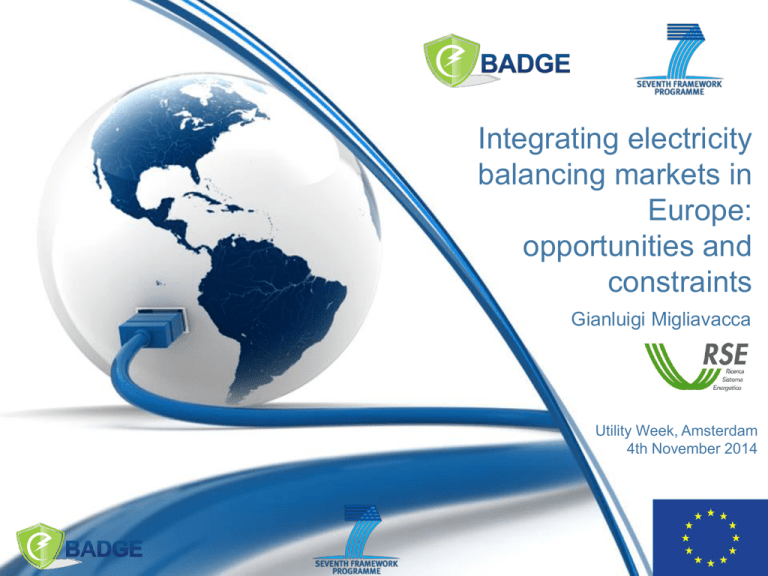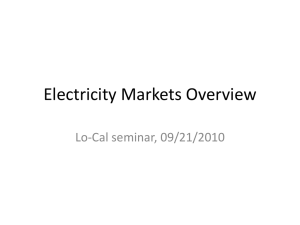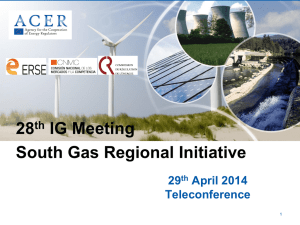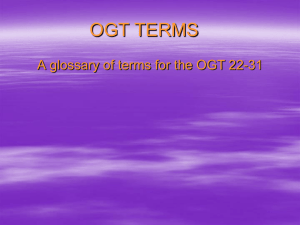Integrating electricity balancing markets in Europe
advertisement

Integrating electricity balancing markets in Europe: opportunities and constraints Gianluigi Migliavacca Utility Week, Amsterdam 4th November 2014 Contents • Why is reserve needed • Different kinds of reserve • Balancing and reserve procurement within the “target model” • Advantages and criticalities of trans-national balancing • Regulatory context • Presentation eBADGE simulator • Presentation of some scenario simulation results Why is reserve needed? RES (wind, solar) Market (s) and operation • Lacking still nowadays a reliable technology for bulk storage, energy has to be consumed as soon as it is produced: power demand and supply have to remain balanced in real time in order to maintain frequency stable • In order to maintain real time balancing, an amount of reserve generation has to stay available to move its program for compensating real time deviations from the scheduled generation and load programs. • Directive 96/92/EC has produced the unbundling of generation and retail from the transmission system operation. GenCos need economic signals to provide reserve services in an economic way: balancing market were created with this aim. • The explosion of variable RES puts the network under increasing stress: (EC 2050 Roadmap: between 31.6% and 48.7% of electricity production from wind by 2050). Need to compensate variability (real time balancing) while maintaining an adequate reserve level from conventional (dispatchable) generation. • Necessity to reduce costs by sharing reserve among the EU Countries. Need to coordinate relevant markets and TSO operation. However, there is a clear competition with CBT in interconnector allocation. • Prompt from EC to complete the IEM progressively coupling the whole market chain from forward till reserve and balancing. In this way, it is possible to increase markets liquidity and optimize the usage of complementary generation resources in different Countries (gas, wind, PV, nuclear…) • VPPs increased penetration (distribution side): can they prove a viable resource within a trans-national balancing/reserve market? • Interaction of reserve/balancing with storage Load Dispatchable generation VPPs Storage Different kinds of reserve Source EWEA • • • ACER definitions: • (Balancing) Reserves – power capacities (MW) available for TSOs to balance the system in real time. These capacities can be contracted by the TSO with an associated payment for their availability and/or be made available without payment. Reserves can be either automatically or manually activated. • Balancing Energy – energy (MWh) activated by TSOs to maintain the balance between injections and withdrawals. Frequency containment reserves – operating reserves for constant containment of frequency deviations from nominal value in the whole synchronously interconnected system. Activation of these reserves results in a restored power balance at a frequency deviating from nominal value. Operating reserves have activation time up to 30 seconds and are activated automatically and locally. Frequency restoration reserves – operating reserves to restore frequency to nominal value after system imbalance. Activation up to 15 minutes, typically managed by an automatic controller. Replacement Reserves – operating reserves used to restore the required level of operating reserves to be prepared for a further system imbalance. This category includes operating reserves with activation time from 15 minutes up to hours. They may be contracted or subject to market. A “target model” for the EU market design In December 2009 the Electricity Regulatory Forum ("Florence Forum"), chaired by the European Commission and composed of all member states and relevant stakeholders, endorsed the establishment of the European Target Model for congestion management in the electricity market. This work, continued in 2010 through the Ad-Hoc Advisory Group to ERGEG, has constituted one the main basis for the Framework Guidelines on Capacity Calculation and Congestion Management. Source ENTSO-E Reserves procurement [MW]: ahead of real time (before gate closure of last market). Reserve can be contractualized or procured with market mechanisms. Balancing energy [MWh]: Close to real time, available reserve can be activated (automatically or manually by the TSO) Advantages and criticalities of a transnational reserve procurement CONS • • • More complicated and requires a better synchronization of the markets (gate closure, harmonization of standard products) Higher ICT costs Ensuring cross-border dispatchability of balancing orders can be nonobvious PROS • Greater dispatching efficiency, costs reduction, less generators in stand-by • Better usage of generation park with “complementary” characteristics Barriers to trans-national balancing markets due to non-harmonized design variables of national regulation (source: eBADGE D2.2) Optimal allocation has to be promoted between cross-border day-ahead trade and balancing Source ENTSO-E The ENTSO-E Network Code on Electricity Balancing Submitted: 23.12.2013 • ENTSO-E, in fulfillment to the Third Package and EC Regulation 714/2009, is working to 15 network codes upon relevant Framework Guidelines from ACER, among which the Network Code on Electricity Balancing that was submitted to ACER for opinion on 23rd December 2013. • The NC EB provides for a phased approach to foster cooperation amongst TSOs in various areas of Balancing. The key concept of Coordinated Balancing Areas. As time passes, the level of cooperation within a Coordinated Balancing Area and between neighboring ones will increase; neighboring Coordinated Balancing Areas will merge; and finally all Coordinated Balancing Area s will merge to reach the final target of a single pan-European Common Merit Order list. • The NC EB creates a level playing field for all potential providers of Balancing Services, including demand side response, energy storage and intermittent sources. • The harmonized processes and the use of Standard Products form a framework for providers to offer Balancing Services to regional or pan-European Balancing Markets based on TSO-TSO cooperation. The eBADGE trans-national balancing market simulator … models only the balancing energy market as a real-time power dispatch, in which: • imbalance values are known before the activation for each modelled zone • (Secondary and tertiary) energy bids are called on the basis of a price merit order up to eliminate all system imbalances. • The amount of cross-border capacity still not allocated after the Intraday trading is assumed as available for the exchange of balancing energy. Features of the simulator: (1) based on historical bids After an in-depth analysis, it was decided to assume both historical balancing bids and historical imbalance figures as known data to be used as an input for the simulation. Pros: historical data naturally incorporate real system characteristics. Cons: difficulty of finding all data and national market characteristics. The presence in our consortium of TSO helped in solving a lot of problems (data incongruences, etc.). Features of the simulator: (2) netting is considered what is the netting? a procedure that allows the compensation of imbalances with different signs between two neighbouring zones. Austria MWh Slovenia Imbalances MWh +50 -20 MWh MWh +30 Imbalances after netting 0 Without netting, the solution is: 1. to accept an upward bid of +50 MWh in order to face the positive imbalance 2. To accept a downward bid of 20 MWh in order to face the negative imbalance With netting, the solution is: to accept only one bid in order to solve the positive imbalance still present in Austria Features of the simulator: (3) cost allocated to the zones generating imbalances Costs should be allocated to the zones creating the imbalances, that could be different from those where generation is activated Austria Upward bid accepted Quantity= 5 [MWh] Price= + 10 [€/MWh] Slovenia MWh In this case the imbalance occurs in Slovenia, so this is a cost for the Slovenian TSO… +5 COST= 5*10=50€ IMBALANCE In a complex network, calculating cost allocation may be very difficult. The routine SCORGE by RSE, implementing the Average Participation algorithm was connected to the simulator Features of the simulator: (4) Secondary and tertiary bids separately considered Simplified rules for selecting between secondary and tertiary bids are needed. They were agreed with the Austrian and Slovenian TSOs. For Austria and Slovenia, if the value of the imbalance is lower than a given threshold, secondary bids are called for activation, otherwise tertiary bids are activated. MWh MWh THRESHOLD THRESHOLD IMBALANCE secondary bids used. IMBALANCE Tertiary bids used. For Italy the approach is the same, but the threshold is based on a percentage of the zonal load. Simulator model min cˆ g - up p g up g up cˆ g up c g up K p g - up g - up EIE Tl VOLL z lz 0 p g - up p g up ENP z z ( EIE z VOEE z EIE z K max( abs ( c g down )) 1 ENP z ) Imbalances z z p g down g down p g - down 0 PTDF g - down cˆ g down c g down K g - down z cˆ To prevent the simulator to perform arbitrage z z ENP z 0 p g up g up z z p g down Imbalances g down z 0 p g - down p g down z ENP z EIE z T l Tl T l Zones and network • NTC values T A- B CH A B FR T B- A • PTDF (power Transfer Distribution Factors) AU SL IT-NO NO->AU -0.06 0.014 0.073 NO->SL -0.04 -0.3 0.24 AU->SL 0.14 -0.22 -0.07 0 0 NO->CN 0 0 0 0 CN->CS 0 0 0 CS->SU 0 0 0 SU->SI 0 0 0 CS->SA IT-CN 0.073 0.24 -0.07 -1 0 0 0 0 IT-CS 0.073 0.24 -0.07 -1 -1 0 0 0 IT-SU 0.073 0.24 -0.07 -1 -1 -1 0 0 IT-SI 0.073 0.24 -0.07 -1 -1 -1 -1 0 IT-SA 0.073 0.24 -0.07 -1 -1 -1 0 -1 Scenarios • Timeframe: 15 minutes • Independent simulations • … from 1 July 2012 to March 2013 (9 months32000 quarter of hours) • Using historical values for imbalances and bids SCENARIO 1 Base Case each zone solves the imbalances with its own resources (no NTC available between zones) SCENARIO 2 Common Balancing Market each zone solves the imbalances with all the resources available (NTC available between zones) RESULTS: Transits (GWh) Base Case AU Common Balancing Market IT-NO SL 145 264 IT-CN IT-CS ITSA 226 99 IT-SI IT-SU 182 202 RESULTS: Transits (GWh) Common Balancing Market 145 264 If we consider that: • Total imbalances = 6286 GWh • Total exchanges = 3894 GWh ..total exchanges are 60 % of the total imbalances that occur in the system!! 226 99 182 202 RESULTS: costs (M€) Base Case Common Balancing Market AU 3,5 5,2 IT-NO 94,8 48,4 SL 20,2 37,3 9,9 IT-CN Total: 177,7 M€ Total: 79,7 M€ -1,3 IT-CS 17,9 IT- 4,4 SA IT-SI -3,2 5,3 3,3 IT-SU 13,2 -4,7 3,2 Conclusions • Simulation results highlight great benefits for the integrated system of a common management of the balancing energy market • The system cost is more that halved (55%), passing from 177,7 M€ (no balancing market) to 79,7 M€ in case a transnational balancing market is implemented; for Italy the cost reduction is of the 60%. • A greater and better usage of interconnections: with this approach an implicit auction is implemented, and this allow an optimal usage of available interconnection capacity. Thank you for your attention… Gianluigi Migliavacca Head of Transmission Planning Research Group RSE S.p.A. via Rubattino,54 20134 Milano E-mail: gianluigi.migliavacca@rse-web.it











